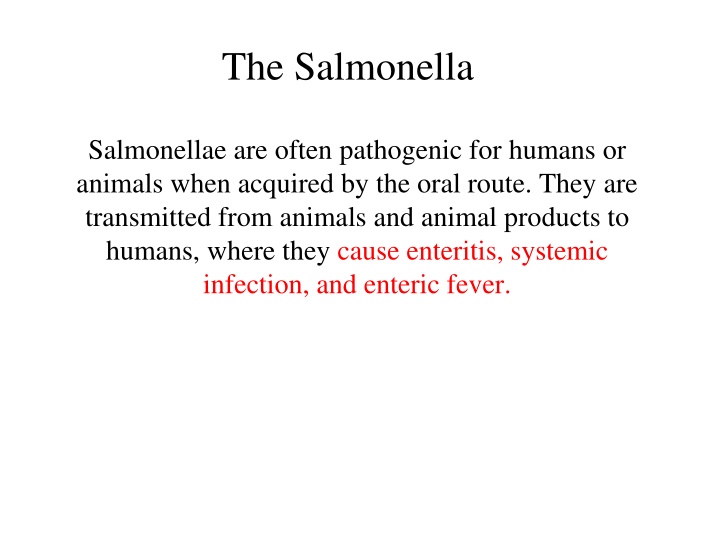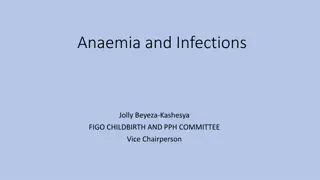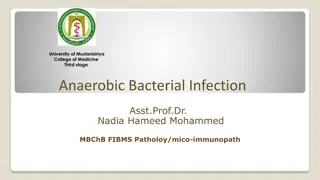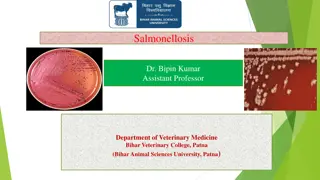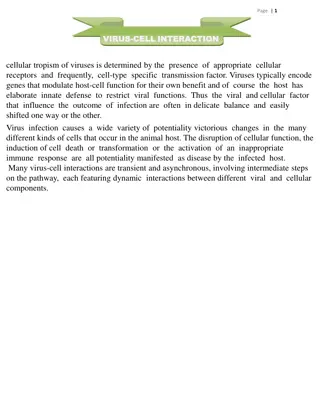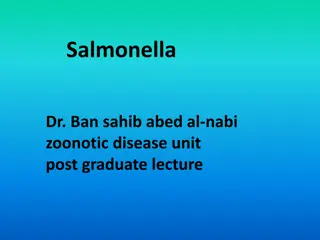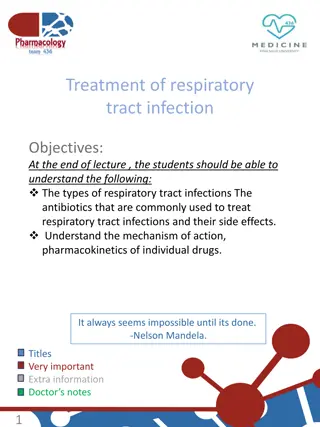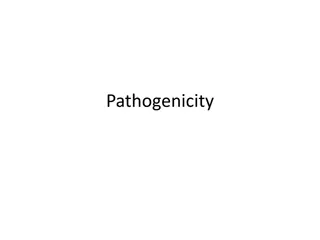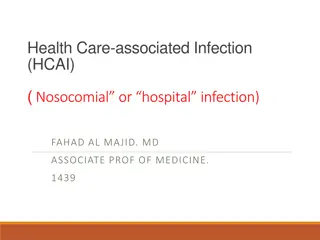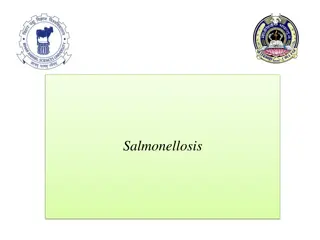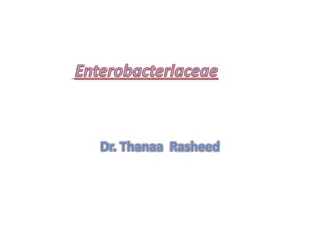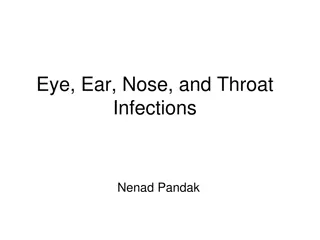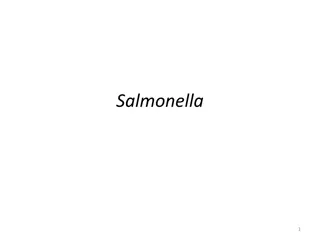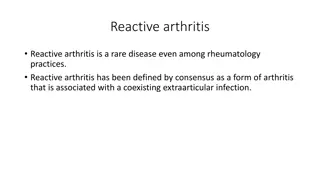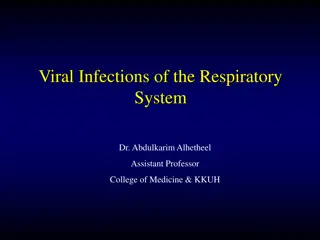Overview of Salmonella Infections and Pathogenicity
Salmonella bacteria, often transmitted through contaminated food or drink, can cause various infections in humans and animals. They are identified by their morphology, and classified into different species and subtypes. The pathogenesis of Salmonella infections varies, with some species infective primarily to humans. The organisms typically enter via the oral route, leading to diseases such as enteric fevers and enterocolitis. Laboratory diagnosis involves cultures from blood, urine, and stool specimens.
Download Presentation

Please find below an Image/Link to download the presentation.
The content on the website is provided AS IS for your information and personal use only. It may not be sold, licensed, or shared on other websites without obtaining consent from the author.If you encounter any issues during the download, it is possible that the publisher has removed the file from their server.
You are allowed to download the files provided on this website for personal or commercial use, subject to the condition that they are used lawfully. All files are the property of their respective owners.
The content on the website is provided AS IS for your information and personal use only. It may not be sold, licensed, or shared on other websites without obtaining consent from the author.
E N D
Presentation Transcript
The Salmonella Salmonellae are often pathogenic for humans or animals when acquired by the oral route. They are transmitted from animals and animal products to humans, where they cause enteritis, systemic infection, and enteric fever.
Morphology & Identification Salmonellae vary in length. Most isolates are motile with peritrichous flagella. grow readily on simple media, but they almost never ferment lactose or sucrose. They form acid and sometimes gas from glucose and mannose. They usually produce H2S. They survive freezing in water for long periods. Salmonellae are resistant to certain chemicals (eg, brilliant green, sodium tetrathionate, sodium deoxycholate) that inhibit other enteric bacteria; such compounds are therefore useful for inclusion in media to isolate salmonellae from feces.
Classification The members of the genus Salmonella were originally classified on the basis of: * epidemiology * host range * biochemical reactions, and *Structures of the O, H, and Vi (when present) antigens. *DNA DNA hybridization. Salmonella is divided into two species each with multiple subspecies and serotypes. The two species are Salmonella enterica and Salmonella bongori
Epidemiology of Salmonella Infection
Pathogenesis S Typhi, S Choleraesuis, and perhaps Salmonella Paratyphi A and Salmonella Paratyphi B are primarily infective for humans, and infection with these organisms implies acquisition from a human source. The vast majority of salmonellae, however, are chiefly pathogenic in animals that constitute the reservoir for human infection.
The organisms almost always enter via the oral route, usually with contaminated food or drink and cause three main disease: A. The Enteric Fevers (Typhoid Fever) Salmonella typhi: The ingested salmonellae reach the small intestine, from which they enter the lymphatics and then the bloodstream. They are carried by the blood to many organs, including the intestine. The organisms multiply in intestinal lymphoid tissue and are excreted in stools. After an incubation period of 10 14 days. B. Bacteremia with Focal Lesions This is associated commonly with S choleraesuis C. Enterocolitis S Typhimurium and Salmonella Enteritidis are prominent.
Laboratory Diagnosis A. Specimens: * Blood for culture must be taken repeatedly. In enteric fevers and septicaemias, blood culture results are often positive in the first week of the disease. * Bone marrow cultures may be useful. * Urine culture results may be positive after the second week. *Stool specimens also must be taken repeatedly. In enteric fevers, the stools yield positive results from the second or third week on; in enterocolitis, the stools yield positive results during the first week. A positive culture of duodenal drainage establishes the presence of salmonellae in the biliary tract in carriers.
B. Bacteriologic Methods: 1. Differential medium cultures:- EMB, MacConkey, or deoxycholate medium permits rapid detection of lactose non fermenters (not only salmonellae and shigellae but also Proteus, Serratia, Pseudomonas, and so on. Gram-positive organisms are somewhat inhibited. Bismuth sulfite medium permits rapid detection of salmonellae, which form black colonies because of H2S production. Many salmonellae produce H2S.
2. Selective medium culturesThe specimen is plated on salmonella-shigella (SS) agar, Hektoen enteric agar, xylose-lysine decarboxylase (XLD) agar, or deoxycholatecitrate agar, which favor growth of salmonellae and shigellae over other Enterobacteriaceae. 3. Enrichment cultures The specimen (usually stool) also is put into selenite F or tetrathionate broth, both of which inhibit replication of normal intestinal bacteria and permit multiplication of salmonellae. After incubation for 1 2 days, this is plated on differential and selective media.
4. Final identificationSuspect colonies from solid media are identified by: * biochemical reaction patterns , and * slide agglutination tests with specific sera.
C. Serologic Methods: 1. Agglutination test In this test, known sera and unknown culture are mixed on a slide. Clumping, when it occurs, can be observed within a few minutes. This test is particularly useful for rapid preliminary identification of cultures. There are commercial kits available to agglutinate and serogroup salmonellae by their O antigens: A, B, C1, C2, D, and E.
2. Tube dilution agglutination test (Widal test) Serum agglutinins rise sharply during the second and third weeks of S Typhi infection. The Widal test to detect these antibodies against the O and H antigens has been in use for decades. At least two serum specimens, obtained at intervals of 7 10 days, are needed to prove a rise in antibody titer. Serial dilutions of unknown sera are tested against antigens from representative salmonellae. False-positive and false-negative results occur. The interpretive criteria when single serum specimens are tested vary, but a titer against the O antigen of greater than 1:320 and against the H antigen of greater than 1:640 is considered positive. High titer of antibody to the Vi antigen occurs in some carriers. Alternatives to the Widal test include rapid colorimetric and EIA methods. There are conflicting reports in the literature regarding superiority of these methods to the Widal test. Results of serologic tests for Salmonella infection cannot be relied upon to establish a definitive diagnosis of typhoid fever
General Characteristics of Shigella Coliform bacilli (enteric rods) Nonmotile gram-negative facultative anaerobes Four species Shigella sonnei(most common in industrial world) Shigella flexneri (most common in developing countries) Shigella boydii Shigella dysenteriae Non-lactose fermenting Resistant to bile salts
The Shigellae Natural habitat of shigellae is limited to the intestinal tracts of humans and other primates, where they produce bacillary dysentery. Shigellae are slender gram-negative rods; coccobacillary forms occur in young cultures. Shigellae are facultative anaerobes but grow best aerobically. Convex, circular, transparent colonies with intact edges reach a diameter of about 2 mm in 24 hours.
All shigellae ferment glucose. With the exception of Shigella sonnei, they do not ferment lactose. The inability to ferment lactose distinguishes shigellae on differential media. Shigellae form acid from carbohydrates but rarely produce gas.
Toxins: A.Endotoxin Upon autolysis, all shigellae release their toxic lipopolysaccharide. This endotoxin probably contributes to the irritation of the bowel wall. B. Shigella dysenteriae Exotoxin S dysenteriae type 1 (Shiga bacillus) produces a heat-labile exotoxin that affects both the gut and the central nervous system. The exotoxin is a protein that is antigenic (stimulating production of antitoxin) and lethal for experimental animals
Lab diagnosis A. Specimens: include fresh stool, mucus flecks, and rectal swabs for culture. Large numbers of fecal leukocytes and some red blood cells often are seen microscopically. Serum specimens, if desired, must be taken 10 days apart to demonstrate a rise in titer of agglutinating antibodies. A. Culture The materials are streaked on: * differential media (eg, MacConkey or EMB agar) *selective media (Hektoen enteric agar or Salmonella Shigella agar. *Colorless (lactose-negative) colonies are inoculated into TSI agar. Organisms that fail to produce H2S, that produce acid but not gas in the butt and an alkaline slant in TSI agar medium and that are nonmotile should be subjected to slide agglutination by specific Shigella antisera.
Lab diagnosis C. Serology: Normal persons often have agglutinins against several Shigella species. However, serial determinations of antibody titers may show a rise in specific antibody. Serology is not used to diagnose Shigella infections.
